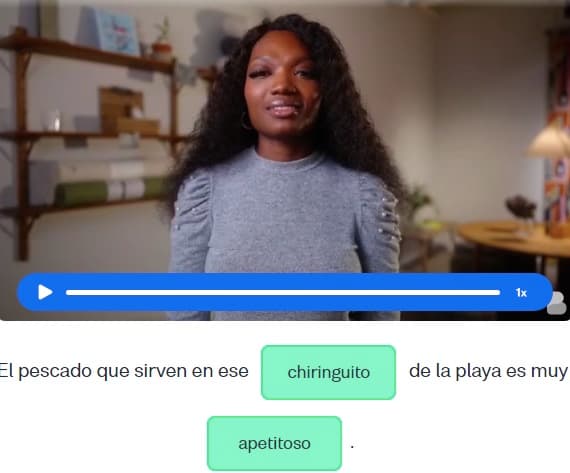I want to learn...
As you learn Spanish, you will realize that there are quite a few types of adjectives and pronouns. Adjectives describe or modify nouns, giving more information about them, while pronouns take the place of nouns, replacing them in a sentence.
The more adjectives and pronouns you learn and know how to use, the broader your vocabulary and the better you can communicate. Using adjectives and pronouns will make your conversations easier and less repetitive!.
In this article, we will focus on demonstratives. Spanish demonstrative adjectives and pronouns are used to indicate the proximity of an object or person to the speaker. They vary according to gender (masculine or feminine) and number (singular or plural). They are placed before the noun, like in English.
What are demonstrative adjectives in Spanish?
Demonstrative adjectives in Spanish are words that accompany and modify nouns, indicating the proximity of the objects or people they refer to in relation to the speaker. They help to specify which object or person is being talked about. Demonstrative adjectives match the nouns they modify in gender (masculine or feminine) and number (singular or plural).
Spanish demonstrative adjectives
| Distance to the speaker | Singular Masculine | Singular Feminine | Plural Masculine | Plural Feminine |
|---|---|---|---|---|
| Near | Este | Esta | Estos | Estas |
| Not so near | Ese | Esa | Esos | Esas |
| Far | Aquel | Aquella | Aquellos | Aquellas |
How to use Spanish demonstrative adjectives
Demonstrative adjectives are pretty straightforward, which is why they will be easier for you to grasp than other types of words and grammatical rules.
Demonstrative adjectives in Spanish must be changed to agree in number and gender with the nouns they modify (here are easy ways to learn the gender of nouns in Spanish).
Examples of singular demonstrative adjectives in Spanish:
Masculine
This handbag - Este bolso
That mobile - Ese móvil
That newspaper over there - Aquel periódico
Feminine
This wallet - Esta cartera
That key - Esa llave
That girl over there - Aquella chica
Examples of plural demonstratives adjectives in Spanish:
Masculine
These handbags - Estos bolsos
Those mobiles - Esos móviles
Those newspapers over there - Aquellos periódicos
Feminine
These wallets - Estas carteras
Those keys - Esas llaves
Those girls over there - Aquellas chicas
Using Spanish demonstrative adjectives in a sentence:
Esta taza de café es mía. (This cup of coffee is mine.) -
¿Es ese tu coche? (Is that your car?)
Mira ese ordenador allí. (Look at that computer over there.) -
Estos cacahuates están deliciosos. (These peanuts are delicious.)
Llévate esas naranjas a casa. (Take those oranges home with you.)
Aquellos chicos son mis hijos. (Those boys over there are my sons.) -
What are demonstrative pronouns in Spanish?
Now that we’ve discussed demonstrative adjectives, let’s turn to demonstrative pronouns.
Demonstrative pronouns in Spanish are words used to replace nouns and indicate the proximity of the objects or persons they refer to in relation to the speaker. Unlike demonstrative adjectives, which accompany and modify nouns, demonstrative pronouns stand alone and represent or replace the nouns in a sentence. For a more in-depth discussion about pronouns in Spanish, check out our guide to Spanish pronouns.
As with demonstrative adjectives, demonstrative pronouns need to match the noun they replace in both number and gender. Good news! They are the same as demonstrative adjectives:
Spanish demonstrative pronouns
| Distance to the speaker | Singular Masculine | Singular Feminine | Plural Masculine | Plural Feminine |
|---|---|---|---|---|
| Near | Este | Esta | Estos | Estas |
| Not so near | Ese | Esa | Esos | Esas |
| Far | Aquel | Aquella | Aquellos | Aquellas |
Using Spanish demonstrative pronouns in a sentence:
Quiero este libro, pero tú prefieres ese. (I want this book, but you prefer that one.)
Estas flores son bonitas; ¿puedo quedarme con estas? (These flowers are beautiful; can I keep these?)
What are neuter demonstrative pronouns?
Demonstrative pronouns are incredibly helpful in conversation and not too tough to remember.
It’s important to note that there are also neuter demonstrative pronouns in Spanish. Let’s discuss what they are and when and how to use them.
These types of demonstrative pronouns are only used in the singular form because there aren’t neuter nouns in Spanish. In Spanish, neuter demonstrative pronouns are used to refer to non-specific things or to something that has not yet been discussed. Additionally, neuter demonstrative pronouns exist to refer to general ideas or concepts.
Neuter demonstrative pronouns in Spanish:
This one - Esto
That one - Eso
That one over there – Aquello
Using Spanish neuter demonstrative pronouns in a sentence:
This is so delicious. -Esto es tan delicioso.
Is that yours? -¿Eso es tuyo?
I don’t know what that over there is called. -No sé cómo se llama aquello.
Keep working to learn more demonstrative adjectives and pronouns
How does it feel to gain a further understanding of the Spanish language? You are doing so well and improving so much! This is especially true because you have gotten to this point where you are not only expanding your vocabulary but broadening your understanding of how Spanish speakers communicate.
Learning a new language isn’t always easy, in fact, it can be quite an undertaking because you have to dedicate a lot of time and put in a lot of effort to learn, practice, and retain each lesson.
As you continue to put in the work, you will see your skills grow. Here at Busuu, we try to create a community and learning experience that keeps you motivated to learn, and we hope you take the time to recognize all of your efforts.
Newlanguages


